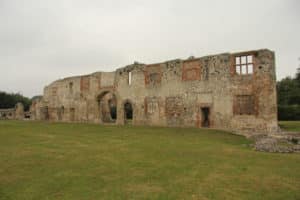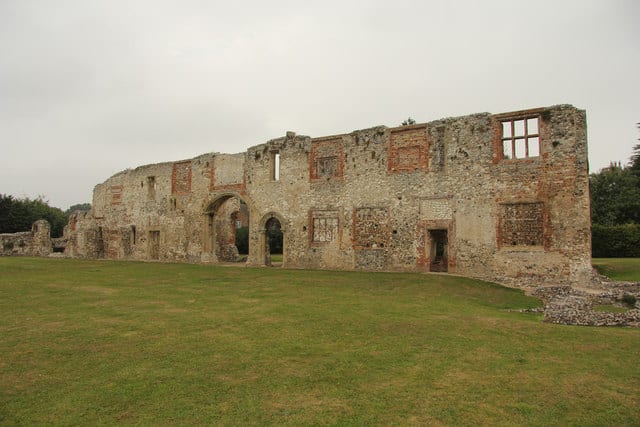
Henry VIII’s suppression of the monasteries was, according to Professor George Bernard, one of the most revolutionary events in English history. “There were nearly 900 religious houses in England, around 260 for monks, 300 for regular canons, 142 nunneries and 183 friaries; some 12,000 people in total, 4,000 monks, 3,000 canons, 3,000 friars and 2,000 nuns. If the adult male population was 500,000, that meant that one adult man in fifty was in religious orders.” Between 1536 and 1540, all of them had to make other plans because all their houses were dissolved. In some cases, the properties were sold or given to Henry’s friends, but many of the buildings were stripped of anything of value, including the lead and slate of the roofs. These became the ruins that dot the English countryside today.
Thetford Priory was one of the most important monasteries in East Anglia, and one of the last to be suppressed. It was originally founded in 1103 by Roger Bigod, the First Earl of Norfolk, and it became the resting place of choice for the Howard dynasty. Even Henry’s own natural son was buried there: Henry FitzRoy, Duke of Richmond and Somerset, had been married to Mary Howard, daughter of Thomas Howard, Third Duke of Norfolk. When Henry VIII first began suppressing the monasteries in 1536, Norfolk, worked hard to save Thetford. He proposed that the priory would be converted into a church of secular canons – and between his plans and his own prominence, he got Henry to agree. Thetford Priory was included on a list of five collegiate churches to be made and erected by the King; no harm would come to it.
Then something changed.
A read-through of the history blames everything on Henry’s capriciousness. Admittedly, by 1540, Henry was spending large sums fortifying his coastal defenses out of fear of invasion by France and Spain so he might have been motivated exclusively by the money, but I can’t help but wonder whether this was one of the pieces in the fight that was going on between Norfolk and Cromwell at the time.
The idea of dissolving the monasteries was a reformist one, originally Cromwell’s brainchild. Norfolk was profoundly conservative – and hated Cromwell not only for interfering with religion but also because of his humble origins (Norfolk was a snob who believed that only people with noble blood were entitled to speak with and advise the King). Cromwell hated Norfolk as well – and back in June of 1539 their mutual hostility came into the open during a heated discussion about Cardinal Wolsey (Cromwell charged Norfolk with disloyalty and Norfolk called Cromwell a liar – it was a big deal).
For the rest of 1539, the two men jockeyed for position. Cromwell retaliated against Norfolk’s spurring Henry to the conservative principles encapsulated in the Act of the Six Articles (nicknamed the Whip of the Six Strings) by forging an alliance with the Protestant states…In early January it looked like Cromwell had won when Henry married Anne of Cleves…and shortly afterwards closed the remaining monasteries, including Thetford Priory.
Cromwell continued to rise for two months after that, being named Earl of Essex on April 17, then Great Chamberlain on April 18. But silently in the middle of all of this, the King had become enamored of yet another wife’s maid of honor…The sands of royal favor shifted, and Henry was persuaded that Cromwell had been motivated by personal gain in arranging the Cleves marriage. On June 10, Cromwell was arrested for high treason; he was executed on July 28, the same day Henry married Catherine Howard.
We know that Norfolk was behind Cromwell’s fall. Would Norfolk have gone after him quite so terribly if Thetford Priory had been spared? Probably yes, since Norfolk was ruthless, but it kind of makes you wonder. I definitely believe it fanned the flames – and I look forward to sharing that approach with you in The Path to Somerset….
* * *
If you like my posts, you’ll love my books! My Seymour Saga trilogy tells the gripping story of the short-lived dynasty that shaped the Tudor Era. Jane the Quene skews romantic, The Path to Somerset is pure Game of Thrones (without the dragons), and The Boy King is a noir coming-of-age. Get them now through Amazon, Barnes & Noble, Kobo, and Apple, or even your local independent bookstore!

(PS Already read them? Did you love them? Then please review them – even just a stars rating! It makes a huge difference in helping new readers find them and would mean the world to me!)

Thanks for yet another informative post, and thank you for this (for me) introduction to Prof. Bernard. I absolutely share his view on the magnitude of the effect of the monasteries’ dissolution and look forward to reading his book: The Late Medieval English Church: Vitality and Vulnerability on the eve of the break with Rome (2012, paperback 2013). I am interested too in the speculation over sale of Church lands as I find reference to this in all manner of research.
So glad to hear you enjoyed! I love this stuff!
Great post! And yes, the dissolution of Thetford Priory did factor into Norfolk’s passion to cut Cromwell down, no question!
The 3rd Duke of Norfolk managed to survive !